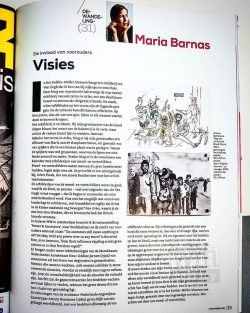“Power & Ancestors” Group Exhibition : Papa Adama (BF), Ron Amir (IL-NL), Margo van Berkum (NL), Rotem Bides (IL), Enrique Collar (PY), Arturo Desimone (AW-AR), Tamar Rozenblat Goiati (NL), Marion Inglessi (GR), Nour-Eddine Jarram (MA-NL), Steven Jouwersma (NL), Terrence Musekiwa (ZW), Hajnal Németh (HU), Casper Prager (NL), Xavier Robles de Medina (SR) 03.03 – 07.04.2018
January 28, 2018 8:56 pmPRESS-RELASE
POWER & ANCESTORS
Group exhibition with visual art works by 14 local and international artists,
with various techniques, including painting, drawing, sculpture, video
– curated by Arturo Desimone & Sebastian Rypson –
Reflecting upon the power of ancestor-worship and objects; their animistic power and their political relevance: Can these traditions serve to confront contemporary hyper-modern society with itself?
Our sanitized time–of digitally-enhanced emotions, de-ritualized “liberated’’ actions, hashtag-ideologies, tele-communicative infants, virtual reproduction and dissemination of information without memory–has delayed our connection to the ancestors. Can the artist steal back the imbued power of the image or object in a talisman? Can the poet snatch back the gravitas of the word? In this realm of instant unlimited gratification, do images retain any meaning still, in their ever-expanding immensity and over-production? Tensions of meaning loosen and sever interconnections between the movements of history and the contemporary; between the story of each object and its depiction; between the relic and its power. Do ancestors still mean any thing to us? Do they hold any power over us any more? Is the artist free, as in immune, from their influence rippling across generations or is that freedom vapid?
The curators of this exhibition advocate for the artist as conjurer. The artist can find a way to approach mystery and memory in a time of public amnesia and the aversion of any confrontation with mortality. The hands of ancestors do play a role in our daily and nocturnal existence, guiding, protecting and tormenting.
This exhibition explores the dead, and the possibility of rich interactions with them. Both natural objects and artistic creations can interact with forces that remain still beyond the grasp of scientific examiners and of designers. Much of the creative class has refused being informed by the dead and mortality itself, preferring stats or to make advertisements for notions of immortality.
The cultural critic Frederic Jameson has argued that “postmodernity”, the cultural logic of late capitalism, is itself an ideology in which there is Space but no Time. The reductive elimination of time itself means the impossibility of “sacred time”, the life-blood of ancestor worship, communication and communion with the dead, and therefore, with the Other.
A radical leap is necessary. We hold an “animist approach”, a return to examples and objects relating to “ancestor worship”, to be that radical jump. We will chisel at the very foundations of the very well-fed but oblivious, miserable and tight-arsed technocrat’s throne, against the guru spirituality of ‘’management.’’ We arrive back at essentials and how we first met in the long, dark, Neolithic night.
Some of the artists descend from immigrants and refugees and owe their existence today to such dangerous migrations. For example, artists like Ron Amir and Desimone harbor an ancestral agenda and cannot shy of referring to the shipwrecked holocaust refugees on islands like Cyprus, or to those who were denied port and safe harbor around the world as they tried to flee Europe: a plight of our ancestors less than a century ago, of which we are reminded today in 2018, by the scandal on Mediterranean islands. “History don’t repeat but the bitch rhymes’’ said an indebted student of Mark Twain while visiting the author’s grave in Elmira, NY. Many other examples entirely unrelated to refugees, yet at odds with the frivolous, are omni-possible and will be sharply present.
The exhibition presents works by:
Papa Adama (Burkina Faso), Ron Amir (Netherlands/Israël), Margo van Berkum (Netherlands), Rotem Bides (Israël), Enrique Collar (Paraguay), Arturo Desimone (Aruba-Argentina), Tamar Rozenblat Goiati (Netherlands), Marion Inglessi (Greece), Nour-Eddine Jarram (Morocco-Netherlands), Steven Jouwersma (Netherlands), Terrence Musekiwa (Zimbabwe), Xavier Robles de Medina (Suriname) Casper Prager (NL) Hajnal Németh (Hungary)
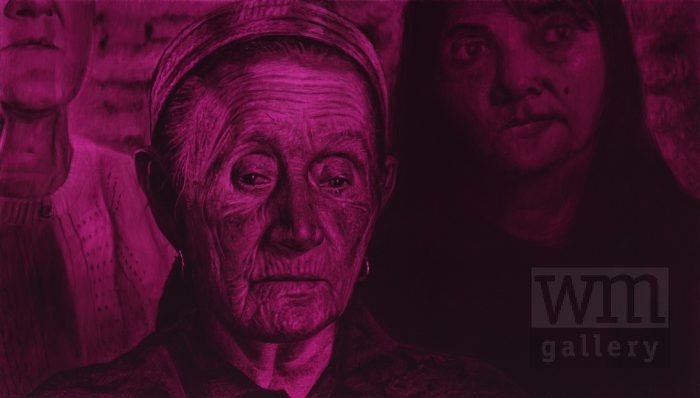
“Film Still” by Enrique Collar
ABOUT POWER & ANCESTORS
by Arturo Desimone
Power and Ancestors was a theme we arrived upon the way a raft riding waves ends up on the shore of a peninsular coast, covered in talismans and starfish. The small wave that transported us there, started with a conversation on the subject of the Voudou, the Afro-Caribbean religion of animism; and about what happens if we attempt to contrast the role of art-works in traditional societies once devoted to animism and ancestor-worship, with the role of art (or the absence thereof) in contemporary, pragmatic and individualist societies. An artist from Burkina Faso had convinced me that the first artist was an animist. I added to his radical statement (radical, after all, means ‘’to get at the roots of things’’, Latin radix) that the first philosopher was a smasher of idols, a disbeliever. An exploration of animism and art was not necessarily specific to Haiti or to Africa: for example, writer Franz Kafka expressed his fascination with it in a defense of idolatry in one of his deathbed aphorisms.
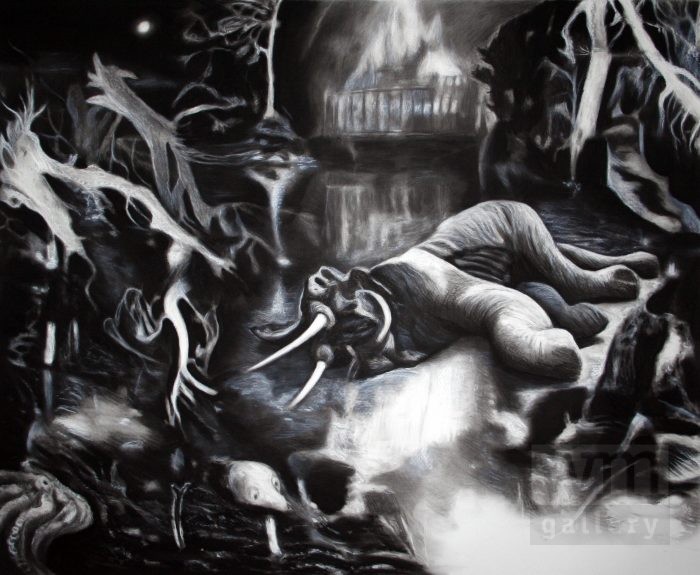
untitled by Ron Amir
Contemporary society only mass-produces images in order to deprive them of animist power: a vulgar fulfillment of Walter Benjamin’s prophetic discourses on the ‘’aura’’ of the artwork in the age of mechanical reproduction (which today has become digital, tele-communicative and virtual, ethereal reproduction.) Can the artists steal back the imbued power of the image or object in a talisman? Can the poets steal back the gravity of the word? Some of them try to restore fire to image and text in this time of unlimited opinion-making and phone-text graphomania. The images expand in this realm of the instant and in the space at hand, broadening and diluting the tensions of meaning, almost as an act of contempt towards the more vertical continuity of images in time: at the expense of memory and the history of images passed on to us.
Anthropologist and co-curator Sebastian Rypson who directs the WM Gallery in Amsterdam pointed out that animism, being a cosmology, seemed far too broad: a line, a vein in that cosmology needed be isolated and taken down into a walled and glassed exhibit.
What may be unknown to most who are vaguely familiar with the term ‘’animism’’ is its direct relation to the animist’s reverence, as well as a dread of the power of ancestors.
In that sense, animism does not as quickly conflict with the acknowledgement of evolutionary theory (though, ironically, animistic traditional cultures were the first victims of European colonialism’s usage of terms borrowed from Darwinist theories of the 19th century. And, animist traditions within Europe were partly effaced by policies of modernization that glorified scientific revolution.)
Both natural objects and artistic creations can interact with forces that remain still beyond the grasp of scientific examiners or of decorators. In many third world societies that still thrive (culturally and socially) today, interactions with the dead and the invisible are regarded as everyday fare.

“Le passé n’est pas si loin” by Nour Eddine Jarram – aquarelle
”What roles do The Ancestors play in our lives? Is the artist free, as in immune, from their influence rippling across the tidal pool of generations?” In most Western post-modern societies, it has become almost unthinkable for two generations to cohabitate under a single ceiling. This Tupperware tidying and separation of generations/bloodlines—advanci
As generations drift apart, turning irreconcilable, the old have no access to interlocutors among the young who can explain a rapidly- changing and newer, frightening world to them. (Interloqui, Latin ”to speak between”) The young and old do not exchange narratives: this mutual starvation results in the instability and hysteria of both youths and geriatrics, who end up lacking the sense of moral chiaroscuro and proportion which a writer like Czech Milan Kundera insisted was the basis for having a sense of humor : the ability to discern what is important from what is unimportant for Kundera constitutes the starting point of the ‘’sense of humor’’, a 6th sense among those distinguishing us from the majority of animals.
Left to their own devices, to their nurses and Big Pharma by their offspring, the old instead are fighting it out in the ballot-boxes that determine frightening developments in politics in, for example the EU, political elections and newspaper opinion columns (all, admittedly, more politicized versions of bingo and tele-bingo). Meanwhile the younger generations have scarce access to the memory and oral history of generational continuity—and, therefore, less of an encounter with such epic yarns and with the visual, tactile and other rich sensory memory of the phantoms of the past: contact with the deceased (rather than the merely aged) ancestors. New languages and codifications have emerged between generations, clubs and other fault-lines, dividing evermore sharply than before. Who will be the interlocutors if we cannot find them among those living and dying?
Do the dead bear a grudge for being forgotten? Is there a language to communicate with the dead in a world where even the living do not speak but rather text with thumb-scroll? This exhibition surpasses implacable clichés like the Ouija board hype of the 19th century.
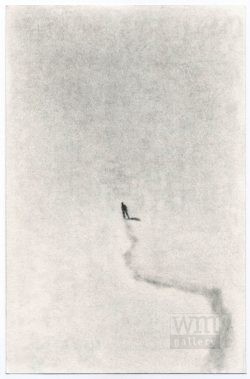
Wanderer (untitled) by Margo van Berkum
The tendency of a somnambulant museum tourist to wave a (phone-) camera, substitute for a wand, on all exhibits in a foreign museum belies a deep mistrust of human memory. A void-chasm in memory and historical consciousness among today’s tech-savvy radicals leads, deceptively, to veiled conservatism and a snide-ness among those drinkers of iced Frappaccino. Leaps backwards and repetitions of what was not even novelty a century ago are represented, sold and bought as ‘’making it new’’ or as radical vanguard-ism. Is progress at all possible in an ex-nihilo vacuum of historical and ancestral consciousness about preceding struggles?
A radical leap is necessary. We hold that the animistic approach, a return to examples and objects relating to ‘’ancestor worship’’, to be that radical jump. Back is forwards. Through this aesthetic junction breakdown, we begin chiseling at the very foundations of the tight-knit oppression and codified, well-fed but oblivious and tight-assed misery of scientific, consumerist and management technocracy. We arrive back at the essentials and how we met each other in the long dark Neolithic night.
The artist can find a way to approach mystery and memory in a time of public amnesia and the aversion of any confrontation with mortality. The hands of ancestors do play a role in our daily and nocturnal existence—guiding, protecting or tormenting.
Some of the artists descend from immigrants and refugees and ow
Arturo Desimone, January 2018
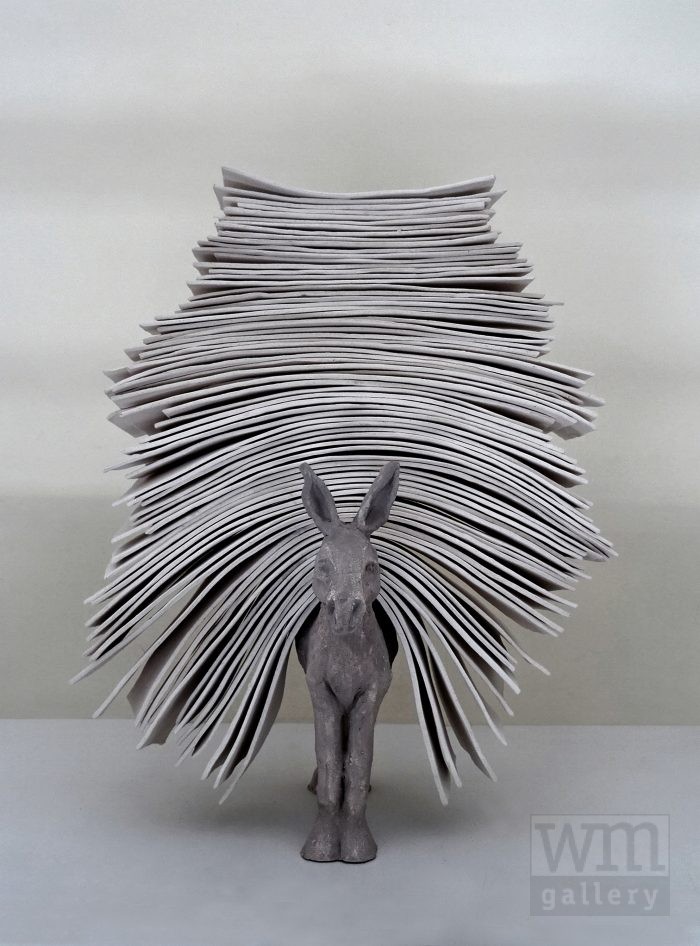
âme-âne (pronounced Amán) Greek : Αμάν. Stoneware, 48cmx40cmx28cm, 2017 by Marion Inglessi. This sculpture is part of an installation celebrating the donkey. Composed of disparate totemic elements, it develops in height in impossible formations maintaining a delicate yet stable equilibrium. The title is a jeu-de-mots as overloaded as the donkey. The Greco-Turkish exclamation amán is used to express toil, longing, sorrow, nostalgia, frustration, indignation, disapproval, but also admiration, joy, and relief. In French, amán sounds like âme-âne, forming the words soul and donkey. The donkey has accompanied us for 3000 years, building all the civilizations around the Mediterranean. However, it has been burdened with an assortment of conflicting epithets, mostly pejorative, to be equaled only by the ones humans use towards each other. Today, deprived of its role as a working-animal, redundant, it had to become endangered before being declared part of a cultural heritage to be preserved, if only ‘to be visited and looked at.’ Marion Inglessi
Artist CV’s

“Nouvelle Noblesse” by Casper Prager
Media
Radio Neverno show by Hans Kuyper
Interview in English with Arturo Desimone by Hans Kuyper from Radio Neverno (from Arti Amicitae Amsterdam) April 2018:
http://radioneverno.blogspot.nl/2018/04/power-and-ancestors-interview-arturo.html
